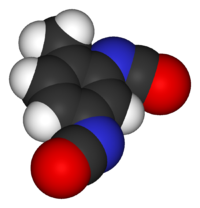Toluene diisocyanate
 |
|
 |
|
| Names | |
|---|---|
|
Preferred IUPAC name
2,4-Diisocyanato-1-methylbenzene
|
|
| Other names
Tolylene diisocyanate
Methyl phenylene diisocyanate |
|
| Identifiers | |
|
584-84-9 |
|
| 3D model (Jmol) | Interactive image |
| ChEBI |
CHEBI:53556 |
| ChEMBL |
ChEMBL1086446 |
| ChemSpider |
13835351 |
| ECHA InfoCard | 100.008.678 |
| RTECS number | CZ6300000 |
|
|
|
|
| Properties | |
| C9H6N2O2 | |
| Molar mass | 174.2 g/mol |
| Appearance | Colorless to pale yellow liquid |
| Odor | sharp, pungent |
| Density | 1.214 g/cm3, liquid |
| Melting point | 21.8 °C (71.2 °F; 294.9 K) |
| Boiling point | 251 °C (484 °F; 524 K) |
| Reacts | |
| Vapor pressure | 0.01 mmHg (25°C) |
| Hazards | |
| Safety data sheet | See: data page |
|
EU classification (DSD)
|
Very toxic (T+) Carc. Cat. 3 |
| R-phrases |
R26, R36/37/38, R40, R42/43, R52/53 |
| S-phrases | (S1/2), S23, S36/37, S45, S61 |
| NFPA 704 | |
| Flash point | 127 °C (261 °F; 400 K) |
| Explosive limits | 0.9%-9.5% |
| Lethal dose or concentration (LD, LC): | |
|
LC50 (median concentration)
|
14 ppm (rat, 4 hr) 13.9 ppm (guinea pig, 4 hr) 9.7 ppm (mouse, 4 hr) 11 ppm (rabbit, 4 hr) |
| US health exposure limits (NIOSH): | |
|
PEL (Permissible)
|
C 0.02 ppm (0.14 mg/m3) |
|
REL (Recommended)
|
Ca |
|
IDLH (Immediate danger)
|
Ca [2.5 ppm] |
| Related compounds | |
|
Related isocyanates
|
Methylene diphenyl diisocyanate Naphthalene diisocyanate |
|
Related compounds
|
Polyurethane |
| Supplementary data page | |
|
Refractive index (n), Dielectric constant (εr), etc. |
|
|
Thermodynamic
data |
Phase behaviour solid–liquid–gas |
| UV, IR, NMR, MS | |
|
Except where otherwise noted, data are given for materials in their standard state (at 25 °C [77 °F], 100 kPa).
|
|
|
|
|
| Infobox references | |
Toluene diisocyanate (TDI) is an organic compound with the formula CH3C6H3(NCO)2. Two of the six possible isomers are commercially important: 2,4-TDI (CAS: 584-84-9) and 2,6-TDI (CAS: 91-08-7). 2,4-TDI is produced in the pure state, but TDI is often marketed as 80/20 and 65/35 mixtures of the 2,4 and 2,6 isomers respectively. It is produced on a large scale, accounting for 34.1% of the global isocyanate market in 2000, second only to MDI. Approximately 1.4 billion kilograms were produced in 2000.
2,4-TDI is prepared in three steps from toluene via dinitrotoluene and 2,4-diaminotoluene (TDA). Finally, the TDA is subjected to phosgenation, i.e., treatment with phosgene to form TDI. This final step produces HCl as a byproduct and is a major source of industrial hydrochloric acid.
Distillation of the crude TDI mixture produces an 80:20 mixture of 2,4-TDI and 2,6-TDI, known as TDI (80/20). Differentiation or separation of the TDI (80/20) can be used to produce pure 2,4-TDI and a 65:35 mixture of 2,4-TDI and 2,6-TDI, known as TDI (65/35).
The isocyanate functional groups in TDI react with hydroxyl groups to form carbamate (urethane) links. The two isocyanate groups in TDI react at different rates: The 4-position is approximately four times more reactive than the 2-position. 2,6-TDI is a symmetrical molecule and thus has two isocyanate groups of similar reactivity, similar to the 2-position on 2,4-TDI. However, since both isocyanate groups are attached to the same aromatic ring, reaction of one isocyanate group will cause a change in the reactivity of the second isocyanate group.
It is used in the production of flexible polyurethane foams
The LD50 for TDI is 5800 mg/kg for oral contact and LC50 of 610 mg/m3 for the vapour. Despite the indicated low toxicity, TDI is classified as “very toxic” by the European Community.
In the United States, the Occupational Safety and Health Administration has set a permissible exposure limit with a ceiling at 0.02 ppm (0.14 mg/m3), while the National Institute for Occupational Safety and Health has not established a recommended exposure limit, due to the classification of toluene diisocyanate as a possible occupational carcinogen. This chemical was one of many that caused two massive explosions in a chemical warehouse stationed in Tianjin, China on August 13, 2015.
...
Wikipedia

